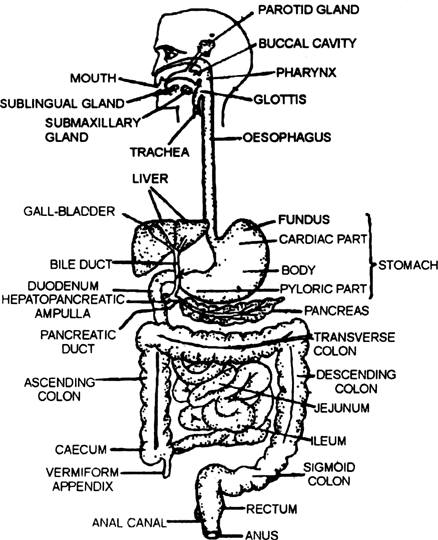A swollen abdomen and legs are symptoms of severe protein deficiency. In such cases, the blood does not contain enough plasma proteins to hold water in the blood vessels and water seeps out of the capillaries and accumulates in the interstitial fluids between cells, especially in the adbominal cavity. thus making the abdomen swell.
Deglutition (swallowing) : The process of swallowing of food is called deglutition. It includes three steps :
1. Movement of food from buccal cavity to pharynx : By the voluntary action of tongue muscles, the masticated food moistened with saliva is formed into a bolus. It is pushed into pharynx by pressing of hard palate by tongue.
2. Movement of food from pharynx to oesophagus : The involuntary contraction of pharyngeal muscles pushes the food into oesophagus. During this time the buccal cavity and openings of nasopharynx and larynx remain closed.
(a) Buccal cavity is closed by the elevation of tongue.
(b) The soft palate is elevated and tensed to close the nasopharynx.
(c) Epiglottis covers the glottis.
3. Movement of food from oesophagus to stomach: Due to peristaltic movements in the oesophageal wall, the bolus travels down through oesophagus into stomach.
Almentary canal : It begins with an anterior opening – the mouth, and it opens out posteriorly through the anus.
i. The mouth leads to the buccal cavity or oral cavity. The oral cavity has a number of teeth and a muscular tongue. It is a transverse slit bounded by two lips—upper and lower. Both the lips are movable. The lips are externally bounded by skin and internally by mucous membrane
ii. The oral cavity leads into a short pharynx. The pharynx has a length of 12 cm. It is a common passage for air and food. T

Fig. Human digestive system
iii. Oesophagus : It is a tubular part of alimentary canal. It is also called food pipe. It has a length of 25 cm and runs parallel to trachea. The oesophagus passes through neck, thoracic and enters into abdominal cavity by piercing through diaphragm. It then opens into stomach. The anterior part of oesophagus has striped muscle and posterior part has smooth muscles.
iv. Stomach : It is J-like and present on the left side at the anterior end of the abdominal cavity posterior to diaphragm on the vental side. The stomach has three major parts – a cardiac portion into which the oesophagus opens, a fundic region and a pyloric portion which opens into the first part of small intestine. The food is temporarily stored and digested in stomach.
v. . Small intestine : It has a length about 6 metres and has 3 parts (i) Duodenum (ii) Jejunum (iii) Ileum.
a. Duodenum : It has length of 25 cm and hepatopancreatic duct opens into it. Food is digested in it and it is more vascular.
b. Jejunum : It is 2.4 m in length. Its wall is thicker than ileum.
c. Ileum : It is 3.6 m. The digestion and absorption occur in it.
vi. Large Intestine : Large intestine has a length of l.5m. It has three parts : caecum, colon and rectum. The caecum is vestigial. The blind vermiform appendix arises from caecum. It is tubular and vestigial organ. The colon has four parts : ascending, transverse, descending and sigmoid colon. Escherichia coli bacteria live in colon which are symbiotic and synthesize vitamin B and K for man. The colon opens into rectum having length of 15-20 cm. The rectum leads into anal canal having length of 2.5cm. It opens out by anus.
vii. Anus : It is an opening surrounded by two anal sphincters. The inner anal sphincter has smooth muscles and outer has striped muscles. Anus is surrounded by wrinkled skin called perineum.
Appendix is a vestigial organ that is found in humans, a few species of great apes. About 6 cm long and 1 cm wide, it is a hollow organ that arises from the caecum. The walls of appendix are muscular and lined with a layer of lymphoid tissue and then an innermost layer of epithelium. It is structurally similar to colon and is also capable of peristalsis. The appendix has no function ; we do not know why humans have one. Since it vaguely resembles a lymph node, the appendix may function to prevent intestinal infections.
Functions of teeth :
1. Cutting and chewing the food. They help in crushing, tearing and breaking the food into smaller particles.
2. Food mastication.
3. They also help in proper uttering of words ans speech.
Functions of tongue :
1. Detecting different types of taste with the help of the taste buds.
2. Tongue assists in the speech.
3. The tongue moves the food around the mouth and towards premolars and molars for chewing.
4. The tongue helps in cleaning of teeth.
5. The tongue helps in swallowing of food.
6. Tongue helps in the mastication of food.
